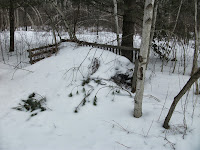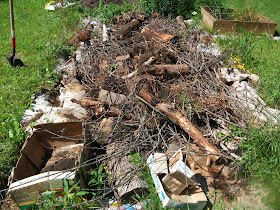During those blink-of-an-eye 9 hours, I stumbled upon a website about Hugelkultur. This is a variation on the lasagna garden. But what is so awesome about it is that you can use up yard waste. I highly recommend you check out a site from someone who really knows what they are talking about, but the gist of it is that you take LOGS ... you heard me, entire trees if you want ... and other debris and toss it into a pile (okay, maybe not entire trees, you'll want to determine the appropriate length of your garden). Then cover it up with mulch, compost, and then a pile of soil. Some of them are really RAISED, as in many feet high due to the logs as the base. The amazing thing is that the logs will continue to decompose, and will literally (yes, literally) self-till the garden for the first few years. Eventually the height will decrease due to the decomposition of the harder material, which is fine with me, as I don't really want a 4-foot high garden (actually, that doesn't sound so bad for weeding).
 The previous owners here left a pile of branches in a spot that I thought was perfect for compost, so my plan was to hugel this pile of yardwaste, which would clear up the space and create a raised garden all at once. Although typical of my approach, I kind of didn't fully follow the method and did things my own way once I got started ...
The previous owners here left a pile of branches in a spot that I thought was perfect for compost, so my plan was to hugel this pile of yardwaste, which would clear up the space and create a raised garden all at once. Although typical of my approach, I kind of didn't fully follow the method and did things my own way once I got started ... I actually spent 6 months very slowly getting this new garden together. It started in the early spring when I laid down some cardboard moving boxes just to get them out of the house and I held them in place with some logs.
I changed the location of the garden several times before the snow melted, and the final spot came after I had a load of soil delivered in April and the truck made very deep grooves in the very wet grass during the dumping. So I decided to cover up the tire tracks with the garden.
I eventually added more logs (most were pine logs I found near an old firepit - I can't use them in my wood stove and don't do a lot of outdoor fires) and branches that had fallen during the winter.
I also kept extending the garden as I obtained more cardboard boxes (from my new lawnmower, from my new wheelbarrow ...).

Long after the snow melted off the pile of yard waste, I went back to clear out the branches (and newly grown foliage) that I had originally planned to use. It turns out there were just a few weeds covering a huge fully-composted mound of beautiful soil! So some of that went on the garden.

Then compost and mulch (both wood chips and hay) was next. And what took so long was the final layer: the soil. There is only about an inch or so of soil on this garden right now. I just wanted to get the mulch covered up for the winter. Depending on how well it all breaks down, I might not have to do anything else. There is a good chance that when the hay breaks down, soil will fall through the cracks in the logs underneath ... but if necessary, I can add more soil in the spring.
It took forever, but was not really much actual effort (thanks to a friend that helped with the last final layer!). And it's full of nutritious mulches, compost and decaying matter that should serve well whichever plants end up on this spot next growing season!









Hi! Just spotted this on your blog. Did this turn out ok for you? I was reading about these earlier in the year and thought they sounded like a good idea.
ReplyDeleteHi Lou! I did not put down enough cardboard and mulch near the bottom so I had a fair bit of grass growing up through the soil. I avoided root veggies when planting as it might take a few years for the logs to fully break down. But the winter squash grew very well in the garden this year despite the grass! I would do this again for sure (in fact I have a low area that gets quite wet each year and I might build it up with logs, mulch and such for another hugel.
ReplyDeleteThanks Susie. Yeh, sounds like a good idea for your wet area. I wish I'd heard of these a few years ago, I have quite a big slope across my allotment and so on one side have raised beds made from pallets to even up the ground level...could've filled them up using the same method...I have lots of thin irregular logs stacked up in habitat piles at the end of my allot from where I cut back a huge old rosemary and buddliea. Hmm well, there's still one spot I could do this, so maybe if I get chance this winter I'll give it a go.
ReplyDeleteI did this and made 15 beds. The reason that I did it was because my allotment is on the banks of the Thames in Oxford and we flood.
ReplyDeleteI dug down to the sub-soil ( just over 4 feet) and filled the hole up with logs,branches,cardboard ( which I collated around the streets in Oxford ) and in one case over a 1000 paperback books.
The beds have sunk down abit and I keep topping them up with compost. I put four wheel-barrow loads a year on top.
I make compost from leaves and grass cuttings which I get from St.Johns College.
The paper book bed grows good rhubarb, by the way.
Ah great idea, old paperback books - got lots of them! 15 beds, wow, great job. I think I'll do another one this year.
Delete